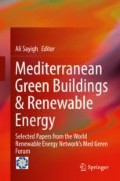Abstract
The energy and environmental impacts due to energy consumption in the building sector are one of the main topics in the global energy field. A building is an energy system that uses energy sources in order to maintain its functionality and to ensure thermal indoor comfort for its occupants. Exergy analysis is a way to assess the impact of an energy system on the environment. This chapter introduces a model able to describe the interaction between a building and its surroundings from an exergetic point of view. The building is considered as a so-called black box, evaluating the exergy of overall energy and matter fluxes that cross the system boundaries. In this way it is possible to evaluate the exergy balance of the system and particularly the destroyed exergy. The exergy destruction percentage can be understood as a building environmental impact indicator. To illustrate the model and its operating suitability, an existing building was analyzed using the transient simulation software Trnsys. The modeling results show that about 95 % of the exergy used from the building is destroyed and that about 5 % is lost (transferred to the surroundings). This means that this building has very high impact. The model can be applied to assess the effectiveness of different building energy retrofit strategies. Through Trnsys modeling some conventional and advanced retrofit strategies, as well as on-site renewable energy utilization, are analyzed. The chapter presents the main analysis results, showing which of these strategies are able to reduce the building’s exergy demand and, hence, the building’s impact.
References
Romero JC, Linares P (2014) Exergy as a global energy sustainability indicator—a review of the state of the art. Renew Sustain Energy Rev 33:427–442
Simpson AP, Edwards CF (2011) An exergy-based framework for evaluating environmental impact. Energy 36:1442–1459
Caliskan H (2015) Novel approaches to exergy and economy based enhanced environmental analyses for energy systems. Energy Convers Manag 89:156–161
Baldi MG, Leoncini L (2014) Thermal exergy analysis of a building. Energy Procedia 62:723–732
Leoncini L (2014) Analisi degli scenari energetici europei e sviluppo di un criterio di valutazione exergetica del sistema edificio. PhD Thesis, Università degli Studi di Firenze
Baldi MG, Leoncini L (2015) Effect of reference state characteristics on the thermal exergy analysis of a building. Energy Procedia 83:177–186
Lohani SP, Schmidt D (2010) Comparison of energy and exergy analysis of fossil plant, ground and air source heat pump building heating system. Renew Energy 35:1275–1282
Yildiz A, Güngör A (2009) Energy and exergy analyses of space heating in buildings. Appl Energy 86:1939–1948
Hepbasli A (2012) Low exergy (LowEx) heating and cooling systems for sustainable buildings and societies. Renew Sustain Energy Rev 16:73–104
Torío H, Angelotti A, Schmidt D (2009) Exergy analysis of renewable energy-based climatisation systems for buildings: a critical view. Energy Build 41:248–271
ECBCS ANNEX 37 (2004) Heating and cooling with focus on increased energy efficiency and improved comfort. Guidebook to IEA ECBCS Annex 37 low exergy systems for heating and cooling of buildings
ECBCS ANNEX 49 (2011) Low exergy systems for high-performance buildings and communities—Annex 49 Final Report
Transient System Simulation Tool [Internet]. www.trnsys.com
Transsolar [Internet]. www.transsolar.com
Sketchup [Internet]. www.Sketchup.com
Office of Energy Efficiency & Renewable Energy [Internet]. http://apps1.eere.energy.gov
Balocco C, Papeschi S, Grazzini G, Basosi R (2004) Using exergy to analyze the sustainability of an urban area. Ecol Econ 48:231–244
Grazzini G, Balocco C (2000) Thermodynamic parameters for energy sustainability of urban areas. Solar Energy 69:351–356
Author information
Authors and Affiliations
Corresponding author
Editor information
Editors and Affiliations
Rights and permissions
Copyright information
© 2017 Springer International Publishing Switzerland
About this paper
Cite this paper
Leoncini, L., Baldi, M.G. (2017). Building Thermal Exergy Analysis. In: Sayigh, A. (eds) Mediterranean Green Buildings & Renewable Energy. Springer, Cham. https://doi.org/10.1007/978-3-319-30746-6_40
Download citation
DOI: https://doi.org/10.1007/978-3-319-30746-6_40
Published:
Publisher Name: Springer, Cham
Print ISBN: 978-3-319-30745-9
Online ISBN: 978-3-319-30746-6
eBook Packages: EnergyEnergy (R0)

